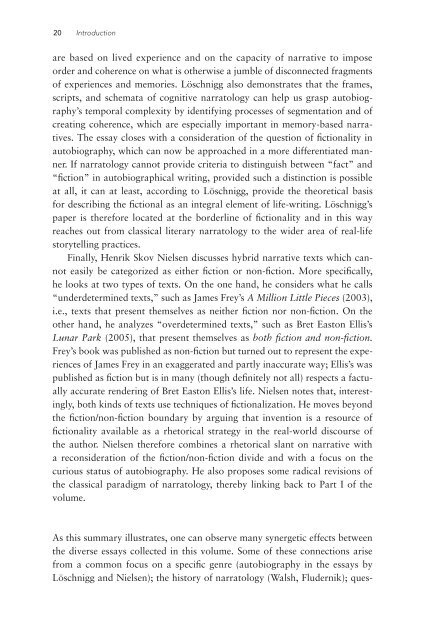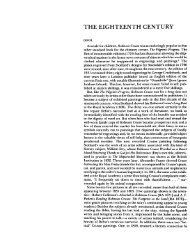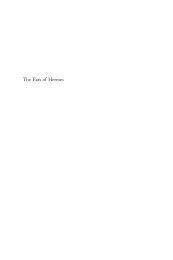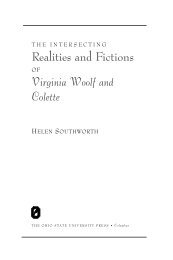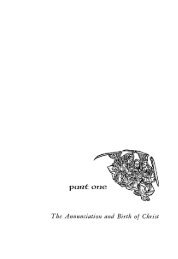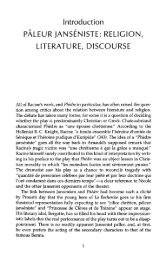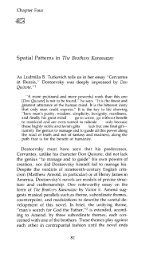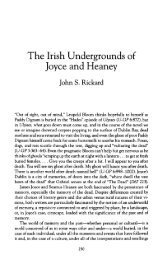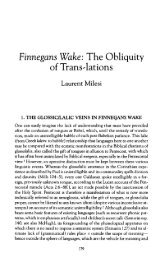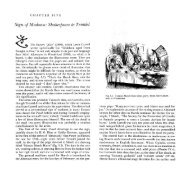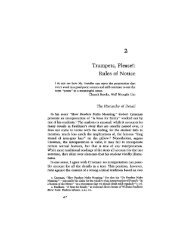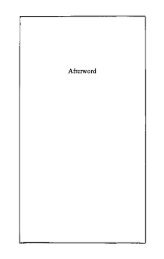Postclassical Narratology: Approaches and Analyses
Postclassical Narratology: Approaches and Analyses
Postclassical Narratology: Approaches and Analyses
You also want an ePaper? Increase the reach of your titles
YUMPU automatically turns print PDFs into web optimized ePapers that Google loves.
20 Introduction<br />
are based on lived experience <strong>and</strong> on the capacity of narrative to impose<br />
order <strong>and</strong> coherence on what is otherwise a jumble of disconnected fragments<br />
of experiences <strong>and</strong> memories. Löschnigg also demonstrates that the frames,<br />
scripts, <strong>and</strong> schemata of cognitive narratology can help us grasp autobiography’s<br />
temporal complexity by identifying processes of segmentation <strong>and</strong> of<br />
creating coherence, which are especially important in memory-based narratives.<br />
The essay closes with a consideration of the question of fictionality in<br />
autobiography, which can now be approached in a more differentiated manner.<br />
If narratology cannot provide criteria to distinguish between “fact” <strong>and</strong><br />
“fiction” in autobiographical writing, provided such a distinction is possible<br />
at all, it can at least, according to Löschnigg, provide the theoretical basis<br />
for describing the fictional as an integral element of life-writing. Löschnigg’s<br />
paper is therefore located at the borderline of fictionality <strong>and</strong> in this way<br />
reaches out from classical literary narratology to the wider area of real-life<br />
storytelling practices.<br />
Finally, Henrik Skov Nielsen discusses hybrid narrative texts which cannot<br />
easily be categorized as either fiction or non-fiction. More specifically,<br />
he looks at two types of texts. On the one h<strong>and</strong>, he considers what he calls<br />
“underdetermined texts,” such as James Frey’s A Million Little Pieces (2003),<br />
i.e., texts that present themselves as neither fiction nor non-fiction. On the<br />
other h<strong>and</strong>, he analyzes “overdetermined texts,” such as Bret Easton Ellis’s<br />
Lunar Park (2005), that present themselves as both fiction <strong>and</strong> non-fiction.<br />
Frey’s book was published as non-fiction but turned out to represent the experiences<br />
of James Frey in an exaggerated <strong>and</strong> partly inaccurate way; Ellis’s was<br />
published as fiction but is in many (though definitely not all) respects a factually<br />
accurate rendering of Bret Easton Ellis’s life. Nielsen notes that, interestingly,<br />
both kinds of texts use techniques of fictionalization. He moves beyond<br />
the fiction/non-fiction boundary by arguing that invention is a resource of<br />
fictionality available as a rhetorical strategy in the real-world discourse of<br />
the author. Nielsen therefore combines a rhetorical slant on narrative with<br />
a reconsideration of the fiction/non-fiction divide <strong>and</strong> with a focus on the<br />
curious status of autobiography. He also proposes some radical revisions of<br />
the classical paradigm of narratology, thereby linking back to Part I of the<br />
volume.<br />
As this summary illustrates, one can observe many synergetic effects between<br />
the diverse essays collected in this volume. Some of these connections arise<br />
from a common focus on a specific genre (autobiography in the essays by<br />
Löschnigg <strong>and</strong> Nielsen); the history of narratology (Walsh, Fludernik); ques-


